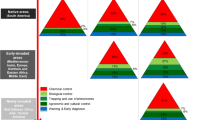Abstract
Microclimatic conditions were monitored in cucumber grown under unheated plastichouses in three consecutive years, i.e. from 1990 to 1992 in Egypt. The relative humidity in the plastichouses constructed on either sandy or clay soil did not exceed 30% during mid-day time, while the average temperature did not drop below 30°C. Such conditions favoured population build up of the two spotted spider miteTetranychus urticae Koch.
In 1993 and 1994, three plastichouses planted to cucumber, cultivar Rawa or Hana were selected. Relative humidity in two of them was maintained over 50% during the day using spraying nozzles, the third being kept as control. Mildew diseases induced by increased leaf wetness needed to be managed using fungicides.Phyioseiulus persimilis andP. longipes were released in the first two plastichouses, while acaricides were applied in the control. In early MayT. urticae population increase on the growing top of cucumber plants required two acaricidal applications as predatory mites did not migrate to the apical leaves which were too warm and dry. More than 80% of the maximum yield was obtained on average in plastichouses using increased relative humidity, but without any acaricidal applications.
Résumé
Les conditions micro-climatiques ont été enregistrées pendant trois saisons successives (1990-92) en cultures de concombres pratiquées sous tunnel plastique chauffé en Egypte. L’humidité relative sous abri construit sur sols sablonneux ou argileux n’a jamais excédé 30% à midi alors que la température moyenne restait supérieure à 30°C, conditions qui favorisaient le développement de pullulations chez l’acarien phytophageTetranychus urticae Koch.
En 1993 et 1994, trois serres plastiques ont été utilisées pour des cultures de concombres des variétés Rawa ou Hana. L’humidité relative a été maintenue en permanence au-dessus de 50% grâce à des pulvérisations régulières d’eau dans deux des trois serres, la troisième étant utilisée comme témoin. L’humidité supérieure ainsi créée au niveau des feuilles a favorisé le développement de mildiou requérant l’application de fongicides. Les acariens prédateursPhytoseiulus persimilis etP. longipes ont été libérés dans les deux premières serres, alors que la serre témoin devait être traitée aux acaricides. Dès début mai, les populations deT. urticae étaient telles aux extrémités des plants de concombres, non visitées par les acariens prédateurs, que deux épandages d’acaricides devaient avoir lieu. Plus de 80% de la production totale potentielle de concombres ont cependant été obtenus sans aucun traitement acaricide, par simple augmentation de l’humidité relative
Similar content being viewed by others
References
Bitton, S. &Nakash, J. - 1983. Biological control of red spider mite by the predacious mitePhytoseiulus persimilis on watermelon in the Jordan Valley. -Phytoparasitica, 11, 133.
El-laithy, A. Y.M. - 1992. Some aspects on the use of the predacious mitePhytoseiulus persimilis Athias-Henriot for biological control of the two spotted spider miteTetranychus urticae Koch in greenhouses in Egypt. -J. Plant Diseases and Protection, 99, 93–100.
Hussey, N. W. &Scopes, N. E. A. - 1977. The introduction of natural enemies for pest control in glasshouse, ecological consideration.In:Ridgway, R. I. &Vinson S. B. (eds). Biological control by augmentation of natural enemies. - Plenum Press, New York and London, 349–377.
Kozirakis, E.- 1983. Present state of biological control on vegetable crops under plastic in Crete, Greece. -OILB/SROP Bull, 6, 12–14.
Kranz, J., Schmutterer, H. &Koch, W. - 1977. Diseases, pests and weeds in tropical crops. -John Wiley and Sons, New York.
Lindquist, R. K., Caseay, M. L., Bauerle, W. L. &Short, T.L. 1987. Effect of an overhead misting system on thrips population and spider mite-predator interactions on greenhouse cucumber.OILB/SROP Bull., 10, 97–100.
Sherf, A. F. &Macnab, A. - 1986. Vegetable disease and their control. -John Wiley and Sons, New York.
Vacante, V. &Nucifora, A. - 1987. Possibilities and perspectives of the biological and integrated control of the two spotted spider mite in the mediterranean greenhouse crops. -OILB/SROP Bull., 10, 170–173.
Yunis, H., Elad, Y. &Mahrer, Y. - 1990. Effects of air temperature, relative humidity and canopy wetness on gray mold of cucumbers in unheated greenhouses. -Phytoparasitica, 18, 203–215.
Walker, J. C. - 1952. Diseases of vegetable crops. -McGraw-Hill Book Company, INC, New York, Toronto, London.
Author information
Authors and Affiliations
Corresponding author
Rights and permissions
About this article
Cite this article
El-laithy, A.Y.M. Integrated control of two spotted spider mite,Tetranychus urticae on cucumber grown under plastichouse conditions in egypt. Entomophaga 41, 485–491 (1996). https://doi.org/10.1007/BF02765801
Issue Date:
DOI: https://doi.org/10.1007/BF02765801




